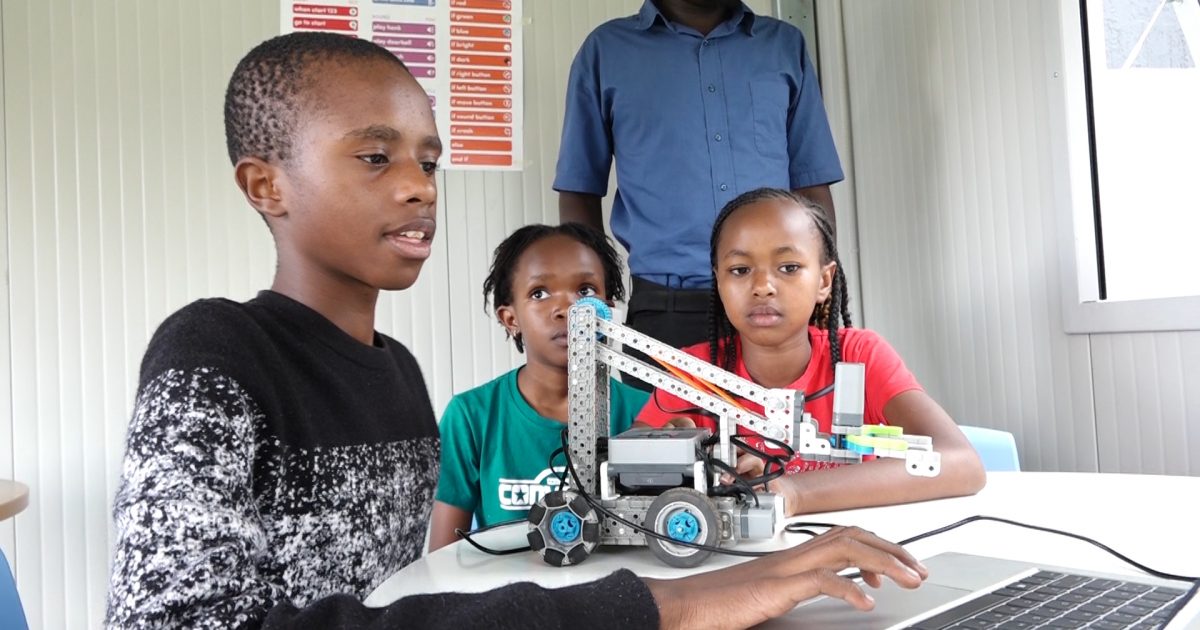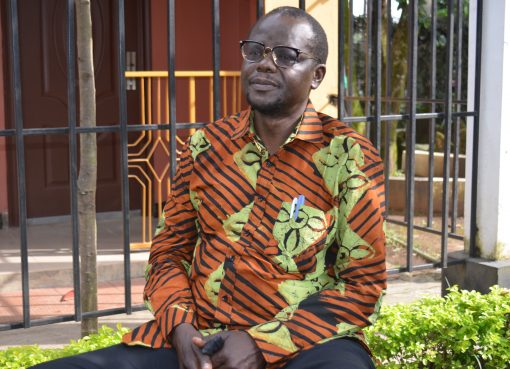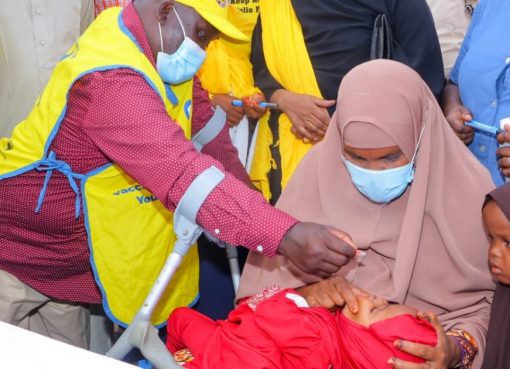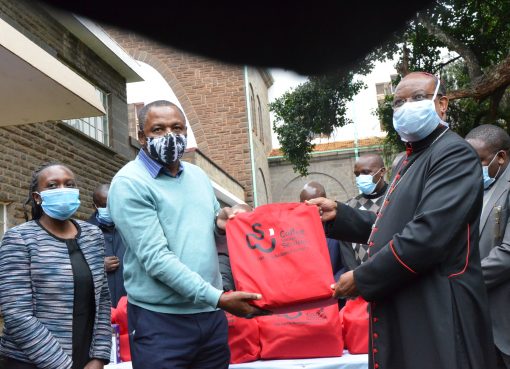Studious silence welcomes you to a science laboratory at Africa Tech -Science Technology Engineering and Mathematics Centre at Naka Estate, Nakuru County.
Inside the facility, Mercy Wangare and Charline Thuo, both aged 10 years, are creating robots using plastic materials spread out on a table during a science lesson.
On the next table, 11-year-old Stephen Kay is glued to a laptop working to programme an already assembled robot so that it can perform various tasks.
The Centre is using robots to teach 48 learners Science, Technology, Engineering and Mathematics (STEM) lessons where they integrate the lessons with Information Communication Technology (ICT).
The learners aged between 5 to 18 years who are on April school holidays and are drawn from various institutions are being enabled to explore robotics, creative coding, physical computing and incubation of viable STEM ideas.
Tutors at the center say the teaching module has not only made learning easy but also full of fun.
The robots are assembled using tiny pieces of plastic consisting of either studs or holes and other standardized components to fit into each other to form one functional unit.
Head tutor Mr. Albert Nyandara says the use of robots makes young learners work in logical and effective ways that foster scientific reasoning and critical thinking which may not be guaranteed in theoretical learning.
Nyandara indicates that the learners also engage in ‘robotic challenge’ that entails assembling and programming which requires a lot of creativity and learning.
Wangare, Thuo and Kay say not only have they enhanced their understanding in learning but also acquired other skills such as communication, team work, tolerance and time management.
Wangare indicates that she has now learnt that computers are not simply machines, but a gateway to innovation, problem-solving, critical thinking and collaboration.
She says that robotics and coding at the centre has made science interesting to learners by engaging them in activities that invoke fun and were not necessarily examinable.
For Thuo, coding is really key in the Competency Based Curriculum (CBC) and in the contemporary world, as people are now looking at Virtual Reality (VR), Machine Learning (ML) and Artificial Intelligence (AI).
“The world is moving away from computers to automation, engineering and robotics. People want to automate systems without having to be there,” adds Thuo.
According to Kay, Kenya needs innovations that could only be realized through creativity and critical thinking as opposed to obsession with academic grades that rarely lead to tangible achievements.
He regrets that science has been badly taught and falsely cast as the preserve of a few extraordinary individuals, a practice that has caused many learners to find it as boring.
Kay says the future as we know it is technology; specifically, robotics. “Robotics is now coming in to help in the health, agriculture and even production sector,” he notes.
For younger learners, the centre is using VEX 123, an interactive and programmable robot which Nyandara says is easy to use for beginners while still offering a greater challenge for those that need it.
The simplest programming is done by inputting sequences via the buttons on the robot itself.
Nyandara explains that those aged over 13 years are subjected to a VEX GO, a STEM construction system that contain all parts, motors and electronics needed to bring STEM to life
“VEX GO is a construction system that teaches the fundamentals of STEM through hands-on activities. This system helps young students perceive coding and engineering in a fun and positive way. Right from Grade 4, children actually start learning how to code. Where the world is heading, we cannot avoid machines. We are helping learners understand the language of machines,” adds the tutor.
He states that the introduction of robotics science, previously a preserve for international curriculum, was aimed at inspiring students in science related careers with a view to inculcating requisite skills envisioned in the competency-based curriculum (CBC).
Nyandara explains that the robotics laboratory at the centre focuses on real life application, sorting, coding and programming to carry out specific tasks.
“We are helping to enhance students’ ability in problem solving, communication and data analytics, creativity, collaboration, technological and critical thinking among other skills. By teaching learners problem-solving skills early through coding, they are better prepared for the world,” adds the tutor.
He states that every parent needs to support their child in venturing into the tech space.
“It is good to have a coder in each household. This would mean that every household would actively participate in the digital economy and can actively participate in creating virtual jobs. As they grow older and upscale their pathways, they can actively involve themselves in different fields. Some of them include mobile app development, drone development,” he notes.
According to Nyandara, the same way Kenyans speak vernacular, Swahili and English, coding is a language but for machines.
He also says that society needs to look at robotics as a way of democratizing STEM and adds that this means making STEM available to learners regardless of where they come from.
Coding or computer programming is the composition of sequences of instructions that a computer could follow to perform tasks that involve designing and implementing algorithms, and step-by-step specifications of procedures, by writing code in one or more programming languages.
The centre is also using Scratch, the first block-based programming language for children aged 8-16 that enables them to create animations, games, music and interactive stories, while learning the basics of coding.
Scratch also exists in the Scratch Junior app version, meant for children aged five to seven, which could be downloaded and used offline. Coding on SCRATCH is basically dragging and dropping blocks.
According to Nyandara, the platform allows one to see the exact code that was used when creating a project.
Different blocks do different things. These blocks include different characters that are referred to as sprites, different looks, sounds, motions, events, variables and even sensors.
He notes that young people learnt best when they create projects that are based on their interests, adding that Scratch is a creative learning tool in coding that is very experimental.
“The Scratch coding programming experience allows young people to build on their passions and interests as they get a chance to learn new things about themselves and the world. Scratch provides one of the lowest floors for getting started in coding. Children are allowed to have their own perspective of things. Through Scratch, they can tinker and explore,” he says adding that it has white walls that enable one to make games, animation and even art projects.
Nyandara explains that when one builds his project on Scratch, it enforces early literacy concepts, cognitive behaviours and enhances skills on computational literacy, such as digital skills, and computing fluency and practices like sharing and remixing.
Centre for Mathematics, Science and Technology Education in Africa’s (CEMASTEA’s) National Trainer in charge of Coding Mr. Martin Mungai indicates that coding is a critical skill that could enable every household to actively participate in the digital economy and in creating virtual jobs.
According to Mungai, mastery of coding will help learners to think differently, be more creative, grasp mathematics easily and be collaborative. He added that it would accord them valuable life skills and prepare them for work.
“We need to know how to grow our technology from primary school. You have heard about coding that is now going to be part of our curriculum to ensure technology becomes part of our journey from primary school all the way to university,” the National Trainer says.
He points out that promoting coding in schools exposes young learners to technology and creates a path to a new world of innovation and creativity.
“Coding is really key in the CBC and in the world we live in today. We are now looking at virtual reality, machine learning and even artificial intelligence. The world is moving away from computers to automation, engineering and robotics. People want to automate systems without having to be there,”
He says Scratch is a creative learning tool in coding that is very experimental. “The Scratch coding programming experience allows young people to build on their passions and interests as they get a chance to learn new things about themselves and the world,” he notes.
The Kenya Institute of Curriculum Development approved coding as a critical skill within the new Competency-Based Curriculum.
By Anne Mwale and Dennis Rasto





